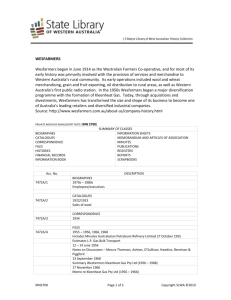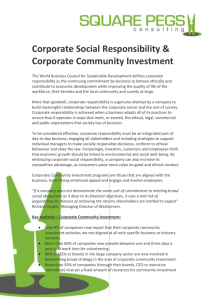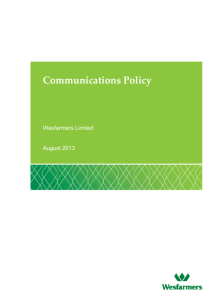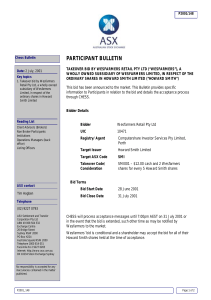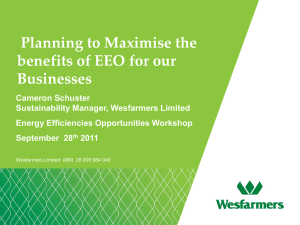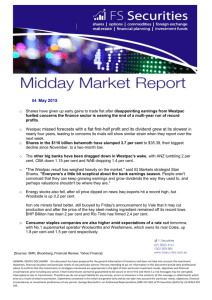NEW YORK (Reuters) - Walgreen Co
advertisement
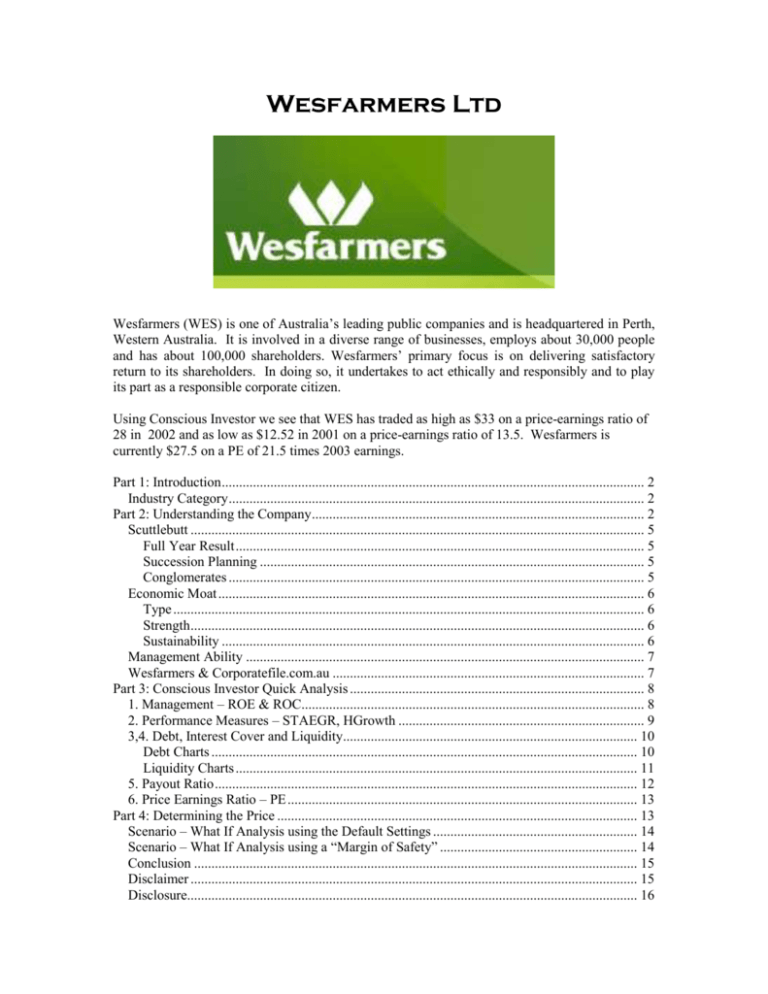
Wesfarmers Ltd Wesfarmers (WES) is one of Australia’s leading public companies and is headquartered in Perth, Western Australia. It is involved in a diverse range of businesses, employs about 30,000 people and has about 100,000 shareholders. Wesfarmers’ primary focus is on delivering satisfactory return to its shareholders. In doing so, it undertakes to act ethically and responsibly and to play its part as a responsible corporate citizen. Using Conscious Investor we see that WES has traded as high as $33 on a price-earnings ratio of 28 in 2002 and as low as $12.52 in 2001 on a price-earnings ratio of 13.5. Wesfarmers is currently $27.5 on a PE of 21.5 times 2003 earnings. Part 1: Introduction .......................................................................................................................... 2 Industry Category ........................................................................................................................ 2 Part 2: Understanding the Company ................................................................................................ 2 Scuttlebutt ................................................................................................................................... 5 Full Year Result ...................................................................................................................... 5 Succession Planning ............................................................................................................... 5 Conglomerates ........................................................................................................................ 5 Economic Moat ........................................................................................................................... 6 Type ........................................................................................................................................ 6 Strength ................................................................................................................................... 6 Sustainability .......................................................................................................................... 6 Management Ability ................................................................................................................... 7 Wesfarmers & Corporatefile.com.au .......................................................................................... 7 Part 3: Conscious Investor Quick Analysis ..................................................................................... 8 1. Management – ROE & ROC................................................................................................... 8 2. Performance Measures – STAEGR, HGrowth ....................................................................... 9 3,4. Debt, Interest Cover and Liquidity..................................................................................... 10 Debt Charts ........................................................................................................................... 10 Liquidity Charts .................................................................................................................... 11 5. Payout Ratio .......................................................................................................................... 12 6. Price Earnings Ratio – PE ..................................................................................................... 13 Part 4: Determining the Price ........................................................................................................ 13 Scenario – What If Analysis using the Default Settings ........................................................... 14 Scenario – What If Analysis using a “Margin of Safety” ......................................................... 14 Conclusion ................................................................................................................................ 15 Disclaimer ................................................................................................................................. 15 Disclosure.................................................................................................................................. 16 Wesfarmers Limited We encourage Conscious Investor® subscribers to follow along on the software and analysis sheets as you work through the report. As well as getting a better understanding of this company, you will also be honing your skills to use Conscious Investor to find and analyze other great companies; the sort of companies that are selling at low prices which you may hold for the rest of your life. Part 1: Introduction Wesfarmers began in June 1914 as the Westralian Farmers Co-operative and for most of its early history was primarily involved with the provision of services and merchandise to Western Australia’s rural community. Seventy years later, with the farmers co-operative as the majority shareholder, Wesfarmers Limited listed on the Australian stock exchange in November 1984. Since then, Wesfarmers has been ranked in the top group of Australian companies when measured by total shareholder return. In April 2001 Wesfarmers completed the transition to a broadly based public company when shareholders overwhelmingly supported a proposal to simplify its complex ownership and control structure. A full corporate profile of Wesfarmers can be downloaded by following the link below: http://www1.wesfarmers.com.au/pdf/CorpProfile2003.pdf Industry Category Wesfarmers can be located in the “Capital Goods” sector along with about 70 other companies. A quick scan of the industry using conscious investor indicates that about 41 of these stocks are currently profitable (current ROE greater than zero), 30 have less than 5 years of history and only 12 have STAEGR greater than 75%. In terms of Market capitalization (price multiplied by the number of shares on issue) Wesfarmers is by far the largest in its sector. The top 5 companies in terms of market cap are as follows: Company Name Wesfarmers Wesfarmers holdings Guiness Peat Group Plc Reece Australia GWA International Market Capitalisation $10.4 billion $2.7 billion $1.0 billion $801.8 million $799.6 million Part 2: Understanding the Company Getting to thoroughly understand a company and its operations in detail is probably one of the most difficult and time consuming steps in investing. I believe one should always attempt to have a clear understanding of the markets in which a company operates and how important the markets or divisions are in terms of the business earnings. Below is a brief description of Wesfarmers main divisions and the markets in which it operates. This has been sourced from the Wesfarmers web site. © Conscious Investing August 2003 2/16 Wesfarmers Limited HARDWARE - BUNNINGS BUILDING SUPPLIES Bunnings Building Supplies Pty Ltd is Australia’s largest specialist retailer of home and garden improvement products and building materials, catering mainly for the do-it-yourself customer, small to medium size builders and owner-builders. In August 2001, the Wesfarmers group completed a takeover of Howard Smith Limited which allowed Bunnings to take control of the BBC Hardware operations of Howard Smith - which include Hardwarehouse, BBC and Benchmark stores across Australia and New Zealand. Bunnings has pursued a strong expansion program to develop a nationwide chain of warehouse stores in all mainland States and Territories of Australia. There is strong customer support for this one-stop shopping format with its powerful combination of broader product variety, high level of skilled service and keenly competitive pricing. ENERGY Wesfarmers’ energy segment incorporates the group’s coal, gas and power operations. Wesfarmers Energy’s coal interests comprise the Premier open-cut operations at Collie in Western Australia’s south-west, the Curragh mine in Queensland’s Bowen Basin and a 40 per cent interest in the Bengalla mine in the Hunter Valley of New South Wales. Wesfarmers Energy’s gas activities comprise Wesfarmers Kleenheat Gas Pty Ltd (distribution and marketing), Wesfarmers LPG Pty Ltd (production and export), Air Liquide WA Pty Ltd (industrial gases) and StateWest Power Pty Ltd (power). CHEMICALS & FERTILISERS - WESFARMERS CSBP Wesfarmers CSBP Limited is the major supplier of chemicals and fertilisers to Western Australia’s agricultural, mining and industrial sectors. CSBP operates a large chemicals and fertilisers complex at Kwinana about 40 kilometers south of Perth in Western Australia and additional fertiliser manufacturing facilities located at regional port centres of Bunbury, Albany and Esperance in Western Australia. In May 2000 the company opened its new ammonia manufacturing plant at Kwinana, completed at a cost of about $150 million. At the same time an integrated ammonium nitrate manufacturing facility at Moura in Queensland was completed, in joint venture with Dyno Nobel Asia Pacific. CSBP employs a network of agricultural advisers who make on-farm visits each year to advise farmers on soil fertility, farm productivity and fertiliser use. The company operates one of the country’s most respected soil and plant testing laboratories which more than 2,000 farmers use each year. Information from this service helps farmers to identify nutrient deficiencies and plant fertiliser programs to maximise farm productivity. RURAL SERVICES - WESFARMERS LANDMARK Wesfarmers Landmark is one of Australia’s largest suppliers of services to the rural sector. The company services over 100,000 clients from almost 300 outlets throughout Australia. It provides clients with livestock, wool, merchandise, insurance, real estate and rural financial services. In key locations around Australia, agronomists have been employed to provide farmers with professional advice on cropping and pasture programs. The company handles about 30 per cent of the nation’s wool clip through its national broking and private buying activities and has developed a range of wool risk management products to assist growers to cope with price volatility. About 20 per cent of the livestock trading in Australia is © Conscious Investing August 2003 3/16 Wesfarmers Limited handled by Wesfarmers Landmark and it is also a leading supplier to the live cattle export trade to South East Asia and the Middle East. Stop Press: Wesfarmers has sold its entire rural trading arm, Wesfarmers Landmark, to monopoly wheat exporter AWB for $825 million in a friendly sale. For details, go to http://www.theage.com.au/articles/2003/08/29/1062050669437.html INDUSTRIAL & SAFETY Wesfarmers Industrial & Safety Division comprises operations across Australia and New Zealand operating under several different trading names including Blackwoods, A.E. Baker & Co, Atkins Carlyle, Motion Industries, Mullings Fasteners, NZ Safety and Protector Alsafe. These businesses were acquired in August 2001 when the Wesfarmers group completed a takeover of Howard Smith Limited. Australian Stock Exchange reports in June 2001 relating to the takeover appear in the news section of this web site. FORREST PRODUCTS - SOTICO Sotico Pty Ltd is a major forest products company based in Western Australia. Its activities include hardwood sawmilling, contract forest harvesting and timber processing to supply local, national and international markets. Sotico produces sawn timber from Western Australia’s jarrah and karri hardwood species. It buys logs from the State government agency responsible for all aspects of native forest management. Sotico has a 50 per cent share in Wespine Industries Pty Ltd which operates a world-scale pine sawmill at Dardanup, 200 kilometres south of Perth. The mill’s main product is machine-graded pine used in roof frames and other building construction. RAIL TRANSPORT Australian Railroad Group Pty Ltd (ARG) commenced operations in December 2000 following the successful acquisition of the Westrail Freight business from the Western Australian Government. ARG is a joint venture owned 50 per cent by Wesfarmers Limited and 50 per cent by the United States based Genesee & Wyoming Inc (GWI). As part of the transaction to complete the formation of ARG, GWI contributed its 100 per cent owned Australia Southern Railroad operations and its interest in the Asia Pacific Transport Consortium which has been selected to construct the Alice Springs to Darwin Railroad. ARG comprises three business units Australia Southern Railroad and Australia Western Railroad conduct the freight operations for the group. The third business unit is WestNet Rail Pty Ltd, the infrastructure company of the group, which holds the lease over the track and manages the access arrangements for all train operators seeking to use the Western Australian rail network. ARG employs over 1,100 staff and has 180 locomotives and 3,800 wagons. As part of the acquisition of the Westrail Freight business, ARG entered into a 49 year lease with the State Government for 5,300 kilometres of track in Western Australia. This is in addition to the 50 year lease plus a 15 year option over 1,290 kilometres of track in South Australia. The diagram below depicts an estimated breakdown of Wesfarmers’ earnings by division. This helps potential investors gain a better understanding of the importance of each division to the overall performance of the company. It’s interesting to note that, going back to 1997, the energy division made up the greatest proportion of earnings at about 40%, followed by chemicals at 35% and then hardware at about 25%. © Conscious Investing August 2003 4/16 Wesfarmers Limited Wesfarmers - Approx Earnings Breakdown by division 6% 4% Energy 29% 13% Chemicals & Fertilisers Hardw are Industrial & Safety Rural 9% Other 39% Scuttlebutt Full Year Result Wesfarmers recently released their full year financial results to the market, with a 5% increase in operating revenue to $7.8 billion. Although this doesn’t sound great, it translated into a 16.4% increase in net profit to $482 million. A fully franked dividend of $0.85 was declared (up 10% on last year). Succession Planning Michael Chaney announced he will be standing down in mid 2005, around two years from now. I’m sure he will be missed deeply by Wesfarmers although with such warning there is plenty of time to groom an internal successor. When Trevor Eastwood left in 1992 the market was similarly concerned as to whether the new successor would be as good. After more than ten years at the top you would think that Michael, along with the board, can find an equally qualified leader. Conglomerates What do hardware retailing, coal production, industrial safety equipment, fertilizers, chemicals and insurance businesses have in common? Very little, and this is why often mention of the word “conglomerate” can send shivers up the spine of most experienced investors. A “conglomerate” is a business with a diverse range of operations. Examples of such companies that have not fared well (to be kind) over the years are Pacific Dunlop and Austrim Nylex. Often they fail as a result of poor management that simply does not know enough about each of the businesses and their operations. Wesfamers has prospered over the years because of their management, culture and focus. Michael Chaney sits above each division ensuring that each division is maximizing shareholder return. Each business unit is run very strictly and very little slack is given for underperformance. Going back only around three years I clearly remember a time when Wesfarmers was being “marked down” by the market (Mr. Market) for being a conglomerate. Comments by analysts, the media and the investment community in general were scathing. This was when Wesfarmers © Conscious Investing August 2003 5/16 Wesfarmers Limited was considered an “old economy” stock and the “tech stocks” were being valued on multiples of sales instead of profit. Although it seems that at present most news regarding Wesfarmers is positive there is likely to be another period of time when it gets marked down by the market for having a diverse range of businesses within a business. It also possible that Wesfarmers’ will, at some stage, go through a “tough patch” for a while. For example, Energy and Hardware growth could slow in unison if the housing market slows. I’m not saying that this will happen, I’m just stressing that there may be times when “Mr. Market” over-reacts and will offer WES with a solid margin of safety. Economic Moat We know that Warren Buffett looks for companies with a strong and sustainable competitive advantage due to the services or products of the company. We refer to this as the economic moat around the company. In the next sections we look at the type, strength and sustainability of the Wesfarmers economic moat. Type For its hardware division, Wesfarmers economic moat is similar to that of Westfield Holdings. Bunnings stores are located in prominent, high traffic positions capturing the demographic of the area very cleverly. Most Bunnings stores have a huge product range and very competitive prices. They have experts within each main area that are very knowledgeable about the products they have to offer. Strength The strength of Wesfarmers economic moat I believe lies in two specific areas, the first being corporate culture and the second scale. Anyone I know that has worked for the group or has been associated with the group has said that the culture within Wesfarmers is incredible. Each of the divisions within the group has clear goals and financial hurdle rates to achieve with consistency. The scale and dominance of Wesfarmers is very apparent in terms of its market capitalization and balance sheet strength. Wesfarmers is certainly poised for acquisitions “at the right price”. Sustainability The question of economic moat sustainability is always a difficult one to answer. With Wesfarmers, the shareholder return focus has lead to continued sustainability in the past. Their track record over a long period of time certainly confirms this. In May, coporateprofile.com.au asked Michael Chaney about Wesfarmers’ five year plan. This is what Michael had to say in response. “Each year our management team meets to discuss longer term strategies, including constructing a five-year financial forecast. That financial forecast invariably shows encouraging growth and this year is no exception. However, it’s inevitable that the actual results turn out differently to our forecasts, sometimes lower and sometimes higher, but the planning process is a useful exercise for formulating business strategies. “ © Conscious Investing August 2003 6/16 Wesfarmers Limited Management Ability Since listing in 1984, current CEO Michael Chaney and his predecessor Trevor Eastwood have built an enviable team. A deeply ingrained corporate culture has been firmly established over 90 years. What impresses further is Wesfarmers approach to acquisitions. In my mind Chaney is very “Buffett Like” in that he hates paying too much for even a quality business. He prefers to wait for the right opportunity to arise and at the right price. This occurred in 2001 with the acquisition of the Howard smith group. This purchase netted Wesfarmers the prized BBC hardware chain – a consistent generator of strong earnings. Wesfarmers & Corporatefile.com.au The Open Briefing service was launched in September 1999 with the support of Australian Stock Exchange. Open Briefings aim to enhance corporate disclosure by delivering a CEO briefing directly to the broadest possible pool of shareholders, prospective investors, analysts and advisors. Since its launch, over 70 ASX-listed companies have participated in the Open Briefing service. For more information on the open briefing service visit the link below: www.corporatefile.com.au Below is an extract from an open briefing service dated 14th August 2003. The full file can be found by following the link below: http://www.corporatefile.com.au/documents/OB/CEO%20on%2016%%20Profit%20Rise%2014. 08.03.pdf corporatefile.com.au: Wesfarmers Limited announced a 16 per cent increase in net profit to $482 million (pre Girrah) for the year to June 30, 2003 (EPS of $1.51 per share before goodwill amortisation, up 9 per cent). That compared with your budget of $494 million. Directors expect the group to continue to record profit growth from business operations in the 2003/04 financial year. In which business segments can we expect the largest improvement, or decline, in earnings? CEO Michael Chaney: The biggest improvements will be in the Bunnings hardware business, rural and industrial and safety, while the biggest decrease will be in energy. Chemicals and fertilisers should be up slightly. corporatefile.com.au: Earnings before interest, tax and goodwill amortisation (EBITA) from the Bunnings hardware business increased by 17 per cent to $349 million. The hardware business experienced a margin reduction associated with input pricing adjustments, inventory shrinkage and write-downs of discontinued product lines but it’s not expected that these issues will impact 2003/04. To what extent did these issues depress 2002/03 profit? CEO Michael Chaney: A fair proportion of the inventory adjustments arose from overestimation of margins in the first half, for example as a result of falling purchasing prices and therefore falling average inventory values; and so are not one-offs. corporatefile.com.au: Wesfarmers is expected to settle soon on its acquisition of Lumley Group for $320 million plus the assumption of $55 million in debt, although the price will be adjusted if Lumley Life is sold to a third party. Wesfarmers has stated that it will operate Lumley general insurance in parallel with Wesfarmers Federation Insurance, because of the largely complementary distribution channels and the different product offering. Without obvious synergies, how can you add value to this acquisition other than from buying it cheaply in the first place? © Conscious Investing August 2003 7/16 Wesfarmers Limited CEO Michael Chaney: We will get some synergies in the area of reinsurance premiums and IT but we do believe we’re buying Lumley at an attractive price and that it will generate good returns. We also think that there’s potential for Lumley to increase its market share, given the rationalisation that has taken place in the industry. corporatefile.com.au: Bunnings’ market share in NSW is below its overall market share in Australia. Can you grow the NSW segment and how can you combat increased competition and difficult trading conditions in Victoria? CEO Michael Chaney: We will continue to build our hardware business in New South Wales and we see it as a good opportunity. We expect to open two new stores in metropolitan Sydney during the next 12 months. In Victoria, we appear to be competing satisfactorily at the moment. corporatefile.com.au: EBITA from Wesfarmers’ energy business increased by 10 per cent to $260 million due to strong growth in coal and gas earn ngs. Bengalla coal mine in NSW again reported below budget earnings while Curragh coal mine in Queensland reported record and ahead of budget earnings. Can you explain the different challenges and opportunities facing these coal operations? CEO Michael Chaney: The real challenge facing Bengalla is export coal prices. It exports thermal coal and if it was exporting coking coal it would be making fantastic returns. The other ongoing challenge for Bengalla is to find new customers to allow for further mine expansion. However, that’s not simple when considering the capacity of other Australian mines to satisfy the market. At Curragh, we intend to increase production by about 0.5 million tonnes per annum for the next few years and we believe there are adequate market opportunities to absorb that. corporatefile.com.au: EBITA from the industrial and safety businesses increased by 38 per cent to $117 million. You’ve been successful by reducing costs and integrating and rationalising the various businesses in this division. Margins and capital efficiency ratios were up strongly. However, normalised revenue was up only 2.4 per cent after allowing for the sale of the metals business. Does earnings growth from this business rely on efficiency gains too much? What are you expectations for product demand and revenue growth? CEO Michael Chaney: This year we’re budgeting for higher revenue growth than registered in 2003 and we expect earnings increases to come through both sales revenue growth and efficiency gains. corporatefile.com.au: You’ve recently expanded the Kwinana ammonium nitrate plant and you’re currently expanding the Kwinana ammonia plant. Are you chasing additional market share or are markets for your chemicals growing? CEO Michael Chaney: We estimate there’s sufficient market growth to cater for the expanded production. Part 3: Conscious Investor Quick Analysis Now we will look at the six areas of the Conscious Investor Quick Analysis. It is recommended that you complete one of the forms as you read through this section and follow along on Conscious Investor. (You can download these forms from the subscriber-only section of the website.) 1. Management – ROE & ROC We can see that ROE/ROC have been consistently above 10% (default setting 10%) for the past six years (currently about 12.5% and 12.2.0% respectively). © Conscious Investing August 2003 8/16 Wesfarmers Limited 2. Performance Measures – STAEGR, HGrowth To assess the financial performance of Wesfarmers, first look at the default chart – Growth. Over the past ten years Wesfarmers has grown its earnings (HGROWTH) at about 12% per annum and sales at about 7.6% per annum. Importantly, both earnings and sales have also grown smoothly (STAEGR) at about 86% and 87% respectively. Over the past five years earnings growth (HGROWTH) has been about 18% per annum and Sales growth about 17.7% per annum. Hint: Play around with recalculating HGROWTH and STAEGR over different periods using the scenarios tool. This will give you a better understanding of the company’s ability to grow its earnings over recent years as well as over longer periods. © Conscious Investing August 2003 9/16 Wesfarmers Limited 3,4. Debt, Interest Cover and Liquidity Debt Charts Wesfarmers has a very strong balance sheet and a solid level of cash flow that enables it to purchase businesses when it is prudent to do so. The current debt to equity ratio of Wesfarmers is about 28% (WES Target between 40% and 65%). This has been steadily falling over the past few years. Interest cover is currently very strong at about 10 times. Source: Wefarmers Annual results Presentation © Conscious Investing August 2003 10/16 Wesfarmers Limited Liquidity Charts Wesfarmers has a current ratio of 1.42 versus the default setting of 1.5. This is consistent with the current ratio over the past 10 years. Its quick ratio is currently about 0.64 versus the default setting of 1. This has improved over the past few years but still remains low. This is because, for Wesfarmers, inventory makes up a large portion of current assets. © Conscious Investing August 2003 11/16 Wesfarmers Limited 5. Payout Ratio Wesfarmers’s payout ratio has remained close to 100% (currently 98.7%) since 1997. Management have been very consistent to shareholders in maintaining this. It is likely that this payout ratio will be maintained in the near term as the company continues to generate strong cash flow and has an under-geared balance sheet. © Conscious Investing August 2003 12/16 Wesfarmers Limited 6. Price Earnings Ratio – PE The PE ratio for Wesfarmers peaked at about 30 times earnings in 2001 and has since dropped off to current levels of around 22 times 2003 earnings. Remember when calculating what price you should pay for this stock it pays to use a conservative future PE Ratio to help build in that all important Margin of Safety. The PE of Wesfarmers has been gradually rising over the past 10 years as investors have been willing to pay a premium for the consistent growth that has been delivered. Part 4: Determining the Price Is this type of company that you would like to add to your portfolio? Is it perhaps one that you could imagine holding for the rest of your life? If so, then the last step is to determine if it is selling at a reasonable price. And if not, what would be a fair price to pay for it. To do this we use the Scenario Analysis in Conscious Investor. The Conscious Investor Scenario Analysis allows us to calculate a range of possible returns depending on what values we choose to input for future earnings growth, PE Ratio at the end of the investment period, Payout Ratio and whether we plan to reinvest dividends in more stock, invest them elsewhere or assume they will be spent. © Conscious Investing August 2003 13/16 Wesfarmers Limited Scenario – What If Analysis using the Default Settings The default settings in this case assume HGROWTH of 11.7% and a PE of 21.5 times. Under these assumptions, assuming an investment period of eight years, the return expected (STRETD) is about 16.7% per annum Scenario – What If Analysis using a “Margin of Safety” Assuming a PE of 18 and an earnings growth rate of 10% per annum (significantly less than the past five years growth rate), the likely return over the next eight years assuming dividend reinvestment (STRETD) is about 13.0% per annum. Using the TARGD tool and the assumptions as above, one would need to purchase at about $24.80 to achieve a likely return of 15% per annum. © Conscious Investing August 2003 14/16 Wesfarmers Limited Conclusion As a conscious investor it is up to you to decide: If you believe that Wesfarmers is a business that you can easily understand, If you are virtually certain that earnings will be materially higher 5, 10 and 20 years from now, If the price is rational Happy Investing! Scott Stanley, Head of Research and Funds Management Alliance Investment & Retirement Services Pty Ltd Phone: (08) 9367 7922, Fax: (08) 9367 7933 Email: scott@allianceinvestments.com.au Web: www.allianceinvestments.com.au Disclaimer The above information does not take into account the particular investment objectives, financial situation and needs of any particular investor. As a result, investors using any of the information contained in this document should assess whether it is appropriate in light of their own individual circumstances before acting on any information provided. © Conscious Investing August 2003 15/16 Wesfarmers Limited The information provided in this document is not intended to give investors specific advice as to whether they should engage in a particular strategy, or buy, sell, or hold any particular security or product specifically mentioned. Any forecasts in the above analysis, whether implicit or explicit, are there only for illustration. They should not be used to replace or guide your own analysis. You should always consult a stockbroker or other authorized financial advisor or representative to establish actual stock prices before making any stock trades or other financial decisions Disclosure Alliance Investment & Retirement Services (AIRS) or an associate of AIRS holds an interest in Wesfarmers Limited. © Conscious Investing August 2003 16/16
